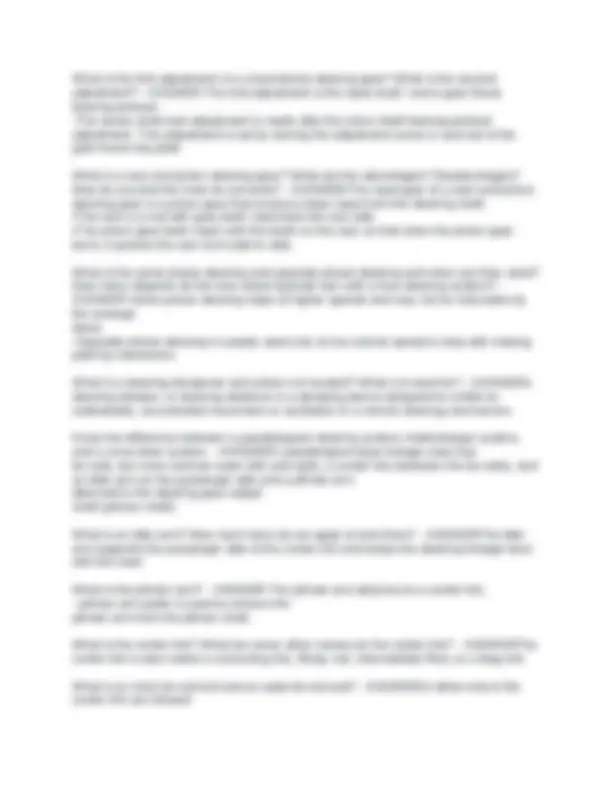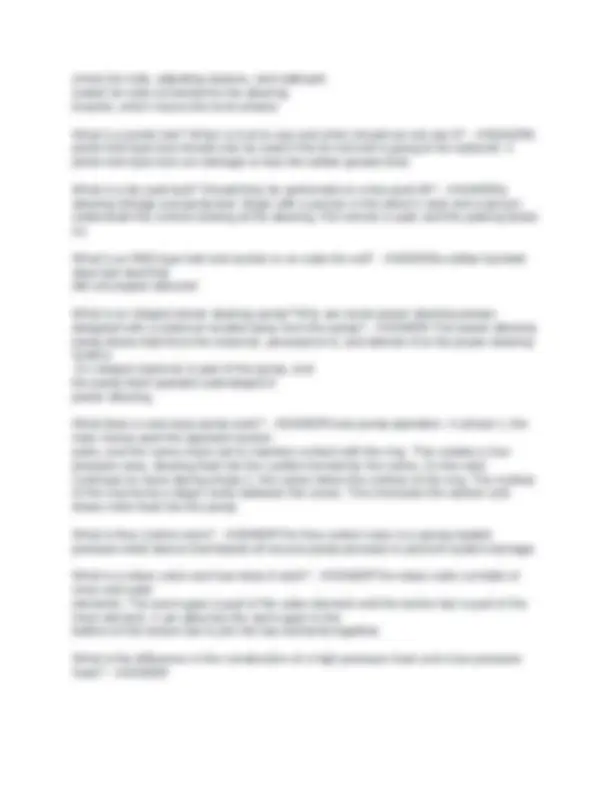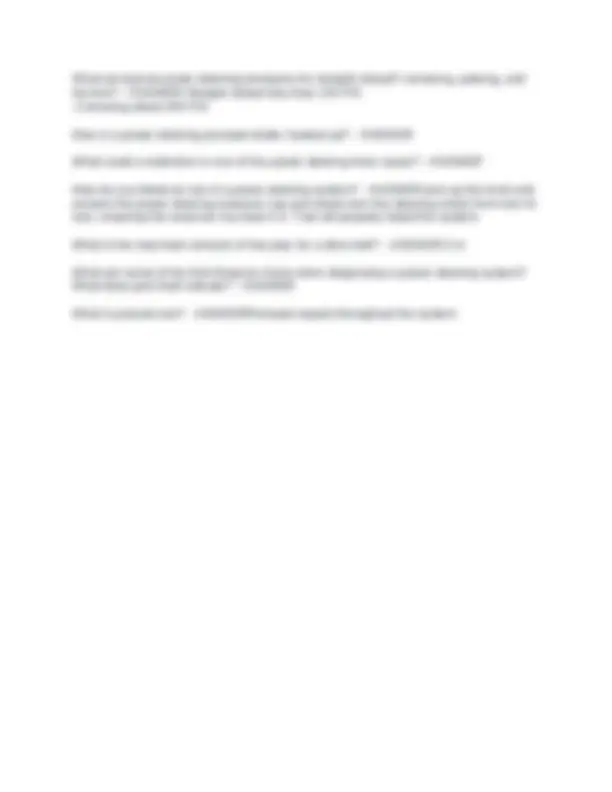





Study with the several resources on Docsity

Earn points by helping other students or get them with a premium plan


Prepare for your exams
Study with the several resources on Docsity

Earn points to download
Earn points by helping other students or get them with a premium plan
Community
Ask the community for help and clear up your study doubts
Discover the best universities in your country according to Docsity users
Free resources
Download our free guides on studying techniques, anxiety management strategies, and thesis advice from Docsity tutors
A comprehensive set of questions and answers related to steering and suspension systems, covering various aspects such as types of power steering systems, steering column designs, flexible couplings, universal joints, steering ratios, conventional steering gear design, rack and pinion steering, steering dampeners, steering systems, tie rod ends, dry park tests, power steering pumps, flow control valves, rotary valves, power steering pressures, bleeding air from the system, and more. It is a valuable resource for students and professionals seeking to understand the principles and operation of steering and suspension systems.
Typology: Exams
1 / 5

This page cannot be seen from the preview
Don't miss anything!




Steering and suspension test 4 Questions & Answers 100% Correct! St [Document subtitle]
What are various types of electrical power steering systems and how do they operate? - ANSWER What are the different types of collapsible steering columns? - ANSWERCollapsible steering columns include a mesh design that crushes easily, a bearing design that allows one section of the column to slide into the other, and a breakaway device that separates the steering column from the body of the vehicle in the event of a front end collision. What is a flexible coupling and why do we have them? - ANSWERA flexible coupling is used to isolate road noise and vibration from the steering shaft What is the difference between flexible coupling and a pot joint? - ANSWER-A pot joint is a flexible coupling used to join two shafts that allow plunging motion. -A flexible coupling is used to isolate road noise and vibration from the steering shaft What is a universal joint? - ANSWERA typical intermediate steering shaft assembly showing a U-joint and related components. How is steering ratio calculated? Is the steering ratio influenced by the number of teeth on the worm gear? - ANSWERThe steering ratio decreases as the steering wheel is turned from the center position. Know how a conventional steering gear is designed. Is the input shaft and the warm gear one unit or two separate parts? - ANSWER•The rotation of the steering wheel is transferred to the front wheels through a steering gear and linkage. •The intermediate shaft is splined to a worm gear inside a conventional steering gear. •Around the worm gear is a ball nut with gear teeth that meshes with the teeth on a section of a gear called a sector gear. •The sector gear is part of a pitman shaft, also known as a sector shaft.
(inner) tie rods, adjusting sleeves, and outboard (outer) tie rods connected to the steering knuckle, which moves the front wheels What is a pickle fork? When is it ok to use and when should we not use it? - ANSWERA pickle-fork-type tool should only be used if the tie rod end is going to be replaced. A pickle-fork-type tool can damage or tear the rubber grease boot. What is a dry park test? Should they be performed on a two-post lift? - ANSWERa steering linkage and pump test. Begin with a person in the driver's seat and a person underneath the vehicle looking at the steering. Put vehicle in park and the parking brake on. What is an RBS type ball and socket on an outer tie rod? - ANSWERa rubber-bonded steel ball stud that did not require lubricant What is an integral power steering pump? Why are some power steering pumps designed with a reservoir located away from the pump? - ANSWER-The power steering pump draws fluid from the reservoir, pressurizes it, and delivers it to the power steering system. -An integral reservoir is part of the pump, and the pump itself operates submerged in power steering. What does a vane-type pump work? - ANSWERVane pump operation. In phase 1, the rotor moves past the opposed suction ports, and the vanes move out to maintain contact with the ring. This creates a low- pressure area, drawing fluid into the cavities formed by the vanes. As the rotor continues to move during phase 2, the vanes follow the contour of the ring. The contour of the ring forms a larger cavity between the vanes. This increases the suction and draws more fluid into the pump. What is flow control valve? - ANSWERThe flow control valve is a spring-loaded pressure-relief device that bleeds off excess pump pressure to prevent system damage. What is a rotary valve and how does it work? - ANSWERThe rotary valve consists of inner and outer elements. The worm gear is part of the outer element and the torsion bar is part of the inner element. A pin attaches the worm gear to the bottom of the torsion bar to join the two elements together. What is the difference in the construction of a high pressure hose and a low pressure hose? - ANSWER
What are typical power steering pressures for straight ahead? cornering, parking, and full lock? - ANSWER-Straight ahead less than 150 PSI -Cornering about 450 PSI How is a power steering pressure tester hooked up? - ANSWER What could a restriction in one of the power steering lines cause? - ANSWER How do you bleed air out of a power steering system? - ANSWERJack up the front end, remove the power steering reservoir cap and slowly turn the steering wheel from lock to lock, ensuring the reservoir has fluid in it. That will properly bleed the system. What is the maximum amount of free play for a drive belt? - ANSWER.5 in What are some of the first things to check when diagnosing a power steering system? What does pink fluid indicate? - ANSWER What is pascals law? - ANSWERPressure equals throughout the system